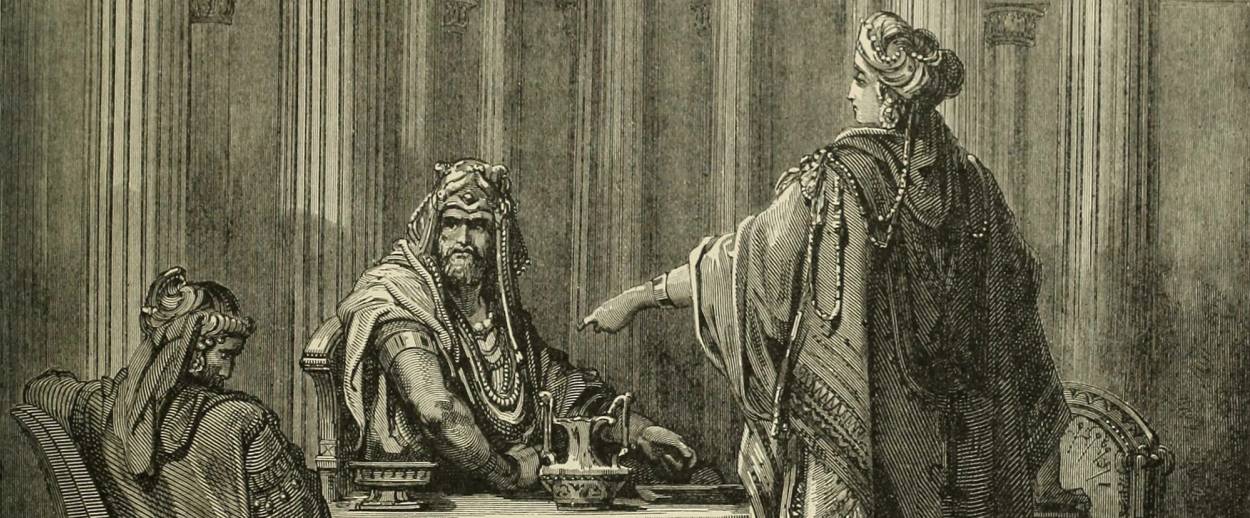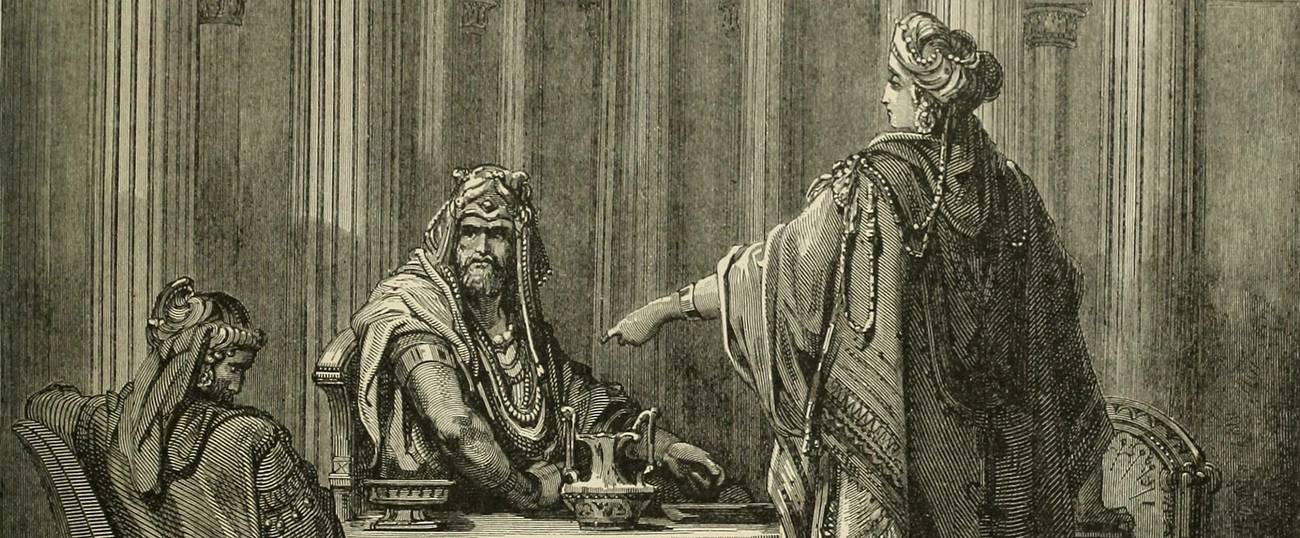The Three Faces of Esther
How the story of Purim is told in Christian scripture, and how Martin Luther became Esther’s enemy




As Purim approaches, the Book of Esther penetrates to the center of Jewish liturgical worship. In both the evening and the morning of the holiday, Jewish congregations around the world will read Megilat Esther.
But as I prepared for Purim this year, I began to wonder what role the Book of Esther plays in Christianity. Its subject—a surprising escape from an attempted genocide against Jews living in the ancient Persian Empire—would seem rather challenging to integrate into Christian theology. The particularity of the narrative, not to mention the hostility toward Jews that became an early facet of Christian life, struck me as not conducive to Esther’s integration into Christianity’s fabric.
One popular misconception is that Jews and Christians share one set of books—what Christians call the Old Testament and Jews call the Tanakh—but not a second set, the New Testament. However, the presence in the Catholic and Eastern Orthodox Old Testament of books such as Judith and Tobit—which are not in the Tanakh—and the appearance of different versions of other books, such as Esther, challenges the popular conception of a one-to-one ratio between one half of Christian scripture and all of Jewish scripture.
In the case of Esther, the differences in the versions that Catholics and Eastern Orthodox Christians include in their canon are quite telling. Perhaps the most famous feature of the Book of Esther for Jews is the absence of God. In the Catholic and Eastern Orthodox versions, however, God is present in the narrative.
When Jews living in Alexandria composed the Septuagint, they chose to rewrite the Book of Esther in Greek. While the version they composed is largely based on the Hebrew version, it is not a translation. In addition, the Septuagint’s version has several key additions: prayer and God. In the Septuagint’s version of the Book of Esther, the heroine prays to God after sending word to Mordecai that he should declare a three-day fast. “On the third day, when she had finished praying, she took off her suppliant’s mourning attire and dressed herself in her full splendor. Radiant as she then appeared, she invoked God, who watches over all people and saves them.” Additionally, this version states that just before she approaches King Ahasuerus, Esther feels faint with fear, but “God changed the king’s heart,” and in his kindness, Ahasuerus invites Esther to come before him. God does not appear as the Great Intervener, as he does in Exodus, but the mere mentioning of Esther’s prayer to God and God’s changing of Ahasuerus’ heart fundamentally alter the nature of the Book of Esther.
The Tanakh’s Book of Esther is unique in large part because prayer and God are not part of the narrative. In fact, along with The Song of Songs, Esther is the only other book in which God is not mentioned. For this reason, Esther has come to represent the dimension of Judaism that emphasizes human initiative, not total dependence on God. By inserting prayer and God into the narrative, the Catholic and Eastern Orthodox Old Testaments removed this aspect of Esther’s uniqueness. The book is flattened into accord with the overwhelming message of Scripture—both Hebrew and Christian—of human dependence upon God.
Part of the ethos of the Protestant Reformation was to recast the Christian relationship to Jewish scripture. For this reason, books that did not appear in the Tanakh but had appeared in the Old Testament were moved to a section called the Apocrypha. Furthermore, Protestant reformers translated into their vernaculars the original Hebrew text of all books in the Tanakh. As a result, the Book of Esther as we know it became the basis for the Book of Esther in the Protestant canon. The additions that were part of the Septuagint but did not appear in the Hebrew original were moved to the Apocrypha.
This decision appears, however, to have been made reluctantly. In one of his Table Talks, Martin Luther—perhaps the most famous of Protestant reformers, and the founder of Lutheranism—said, “I am so great an enemy to the second book of the Maccabees, and to Esther, that I wish they had not come to us at all, for they have too many heathen unnaturalities. The Jews much more esteemed the Book of Esther than any of the prophets.” Luther’s comment is curious because the strong opinion he enunciates is not explicated in detail. The reason for his enmity to Esther is that it contains “too many heathen unnaturalities,” but he does not specify what those “unnaturalities” are. By “heathen unnaturalities,” he was likely alluding to God’s absence from the text, but God’s absence had already troubled earlier Christians, which is why they rewrote the Book of Esther rather than translate the original Hebrew into Greek.
Luther, of course, is a rather loaded, negative figure in Jewish history. While early in his career he showed favor to Jews, by the end of his career he manifested furious hatred toward them. Some of his remarks, which call for the killing of Jews, appear to some as a precursor of Nazism. That debate merits its own independent discussion. Without knowing for certain why Luther was “so great an enemy” of the Book of Esther, I would suggest what might have excited Luther’s dislike, based on those features of Esther that are most cherished and well-known about Esther among Jews today.
For contemporary Jews, the Book of Esther is valued for its female protagonist, its absence of God—which denotes secularism and history—and its positive depiction of assimilation and assimilated Jews. Purim may be, as Rabbi Yitz Greenberg has argued, the Jewish text that most fits the situation of Jewry, particularly American Jewry, in the modern period.
Because of God’s absence and the lack of miracles, the Book of Esther emphasizes the importance of human initiative and undermines the religious notion that one must be completely and utterly dependent on God in order to be obedient to him. Esther’s propitiation of King Ahasuerus and Mordecai’s foiling of a plot to kill the king are examples of how human action is the primary shaper of events. While many of us think we might like to live in the world of the exodus in which Moses raises his rod, the sea parts to the left and right, and our enemies are drowned, we recognize that our world is actually more similar to the one depicted in Esther than the one depicted in Exodus.
The other two best-known aspects of Esther—its female protagonist and its admission of assimilation—are equally radical. In the Tanakh, the theme of endogamy, marrying within the ethnic community, is rather pronounced. Yet in the Book of Esther, the protagonist is a woman who marries a non-Jew. Marriages between Jews and non-Jews are a feature of the Tanakh, even the Pentateuch; Moses himself marries the Midianite Zipporah. But a Jewish woman marrying a non-Jewish man seems so far afield from the other books of the Tanakh that it startles. The aspects of a female protagonist and assimilation, therefore, intertwine in the Book of Esther as they do nowhere else in the Tanakh.
I would suggest that this intertwining, which is unmistakably the core of the Book of Esther, was the reason why Luther considered himself an enemy of the book.
One of the most surprising features of anti-Semitism in the 19th century is that it was directed as much, perhaps more, at Jews who were integrated into their countries as those who kept themselves apart. Jewish assimilation was regarded as one of the primary threats posed by their emancipation. To understand this, we have to recall that assimilation is a broad word that might speak to several degrees of Jewish integration into general society. The rate of intermarriage in the 19th century was much smaller than it is today, and while conversion of Jews to Christianity was greater, conversion and assimilation cannot be considered synonymous. Assimilation by European Jews most often meant an endogamous family life combined with as thoroughgoing and pervasive an engagement and integration into general society as possible. Esther, therefore, represents an extreme form of assimilation, one that is more common today than perhaps ever in Jewish history, in which a Jew marries a non-Jew but remains committed to Judaism.
The change within Luther with respect to Judaism was an outcome of the Jews’ rejection of him. Early in his career when he showed the Jews friendliness, Luther hoped that Jews would regard his teaching as truth and convert to Christianity. Once he saw that would not occur, Luther’s affection turned to wrath. Knowing that, one can see how Esther’s marriage to King Ahasuerus, which was an intermarriage without her conversion, would incite Luther.
To address the role a female protagonist may have played in Luther’s hostility to the Book of Esther, I will once again jump from Luther’s era—the 16th century—to the anti-Semitic period in Europe of the late 19th and early 20th century. In his biography of Franz Kafka, Saul Friedlander remarks upon the “anti-Semitic tags about the feminization of the Jewish body (and personality), common in Central Europe at the turn of the century.” In short, anti-Semitism and misogyny synthesized in a certain respect wherein the Jew was a woman and the woman, a Jew. Given the hyper-masculinity that was emblematic of the Nazis, one can see how the Jew-as-woman identification was essential to Nazism. A straight line does not lead from Luther to Nazism. One has to pause, however, to consider whether here, too, Luther’s enmity to the Book of Esther and his enmity toward Jews bespeaks an early incarnation of the genocidal hatred that developed in Germany 400 years after Luther’s Reformation.
In the aftermath of the Shoah and Vatican II, Christians sought to transform their relationship to the Jewish people and also to the Jewish people’s sacred texts. Of late, enthusiasm for the Book of Esther has been marked. The 2004 best-selling novel Hadassah: One Night With the King enjoyed such popularity that it was turned into a movie and grossed more than $13 million worldwide. In 2014, Rebecca Phillips asserted in Tablet that “Christians are definitely having an Esther moment.” She cited examples from across the country, including both evangelical and liberal mainline Protestant groups, whose religious leaders were turning to the Book of Esther for guidance and inspiration. Esther’s capacity for self-sacrifice—“if I am to perish, I shall perish!” (4:16)—her role as a female protagonist and the book’s secular character have drawn these Christian leaders to it. The rebirth of interest in Esther among Christians is one of the many indicators of the age of reconciliation between Jews and Christians in which we live. As we celebrate the holiday of Purim and read the megillah, we ought to relish the shared sense of connection that we have to this illuminating book.
Matthew Abelson is Rabbi of Kesher Zion Synagogue in Reading, Pennsylvania. He is a graduate of the Jewish Theological Seminary, where he received ordination and a masters’ degree in Jewish Thought.